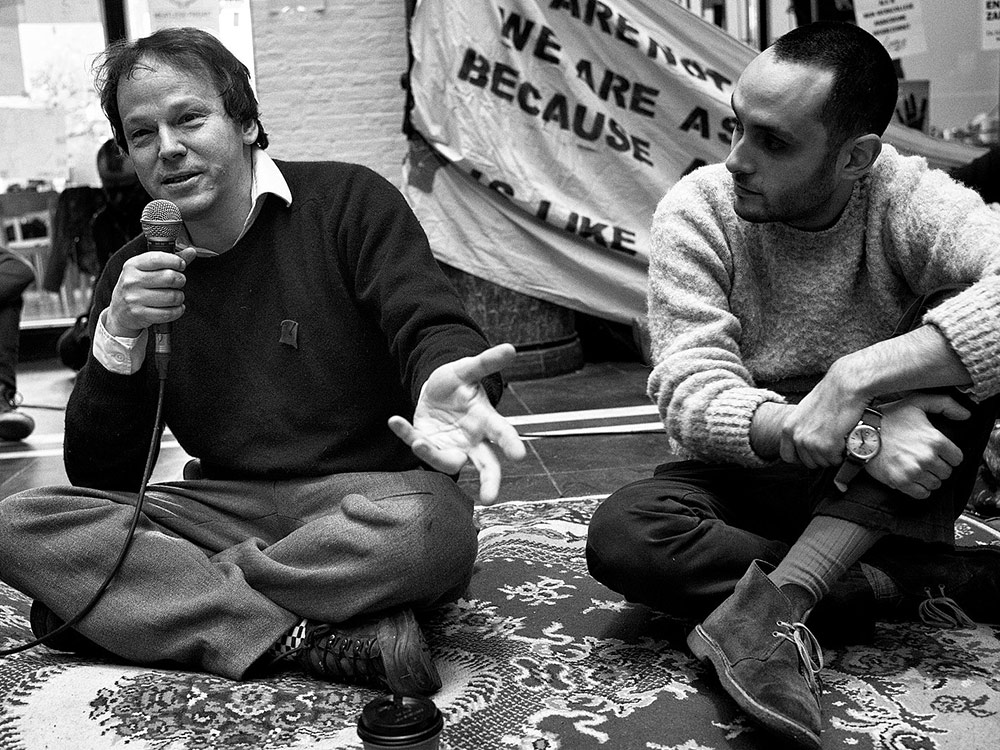Ancient humans had a flexible knack for reorganizing societies that weren’t working.
We can, too.
Crawford Kilian 22 Nov 2021 | TheTyee.ca
Crawford Kilian is a contributing editor of The Tyee.

Crawford Kilian 22 Nov 2021 | TheTyee.ca
Crawford Kilian is a contributing editor of The Tyee.

Anthropologist and anarchist David Graeber, co-author of The Dawn of Everything, speaks at a protest occupation at the University of Amsterdam, 2015. To his right, political theorist Enzo Rossi. Photo via Wikimedia.
The Dawn of Everything: A New History of Humanity
By David Graeber and David Wengrow
Farrar, Straus & Giroux (2021)
This book is plain fun — an intellectual romp through 200,000 years of human history that overturns all the conventional wisdom about our ancestors. And it offers encouraging new directions for social change.
David Graeber, who died in 2020, was not only an anthropologist but an anarchist. Not a bomb-thrower, but a believer in people sorting out their problems, agreeing on the solutions, and carrying on — without coercion. He was a leading figure in the Occupy movement 10 years ago and is said to have coined the phrase “We are the 99 per cent.”
David Wengrow is an archaeologist, and the two created this book over a decade as a kind of hobby, swapping the manuscript back and forth as it gained more documentation, and realizing it would need at least three sequels to cover the material properly. I hope Wengrow can provide at least some of those sequels, but this book is a feast in itself.
First all, it’s full of surprising and fascinating information about the societies of the past, especially since the end of the Ice Age about 12,000 years ago. The information may be well known to experts, but it hasn’t reached the general public yet.
I was amazed to learn that the people who built Stonehenge had experimented with farming and rejected it; they built a new economy based on gathering hazelnuts. Similarly, the vast Toltec city of Teotihuacán, near modern Mexico City, supported a population of 100,000 — most of them living in excellent social housing.
Second, and more important, Graeber and Wengrow use this information to overturn the whole myth of “progress” from hunting and gathering to farming to cities, kings and bureaucracies, and then to the modern industrial state. That myth assumes our ancient ancestors lived in small groups for 200,000 years, rarely interacting with others. Then they invented farming and began to live in larger communities. Only then did social complexity and surplus food supply permit the rise of social institutions like monarchs who commanded great projects built by obedient subjects, with literate bureaucrats to collect taxes and record events.
Resources for centuries-long projects
On the contrary — the peoples of the Stone Age, this book contends, were as intelligent and rational as we were, and quite capable of projects requiring hundreds or thousands of workers, over very long periods of time. When they felt the need, they experimented with social models. Instead of living in a brutal Hobbesian war of all against all, they travelled and traded safely over great distances.
They also had the resources to support projects like Poverty Point, a huge system of earthworks in Louisiana started 6,000 years ago and continued for 600 years. We have no idea what the system’s purpose was, but it required co-operation and logistical support on a grand scale for many generations. Thousands of years later, another civilization we call Cahokia rose on the Mississippi near St. Louis. Graeber and Wengrow suggest it collapsed when it became totalitarian:
“For those who fell within its orbit, there was nothing much between domestic life — lived under constant surveillance from above — and the awesome spectacle of the city itself. That spectacle could be terrifying. Along with games and feasts, in the early decades of Cahokia’s expansion there were mass executions and burials carried out in public.”
Graeber and Wengrow argue that Cahokia fell thanks to three freedoms enjoyed by our hunter-gatherer ancestors: the freedom to walk away, the freedom to disobey, and the freedom to choose new kinds of social organization. Moreover, the horror of Cahokia traumatized the peoples of eastern North America into ever considering such a “civilized” society again.
So when French settlers arrived in what is now Canada, they found Indigenous peoples living in small communities, farming and foraging. But they lacked the great structures and institutions that the French defined as civilization. That meant the Indigenous peoples were “savages.”
The Mi’kmaq and Huron-Wendat thought no better of the newcomers. They had some useful gadgets like firearms, but they were always quarrelling, and always obeying someone else’s orders.
French Jesuit missionaries got a shock from the people they had come to convert. The “savages” could argue them point for point, and defeat them. Thousands of years of Indigenous spoken discourse had made reasoned debate a valued skill, beating even the Jesuits’ training.
‘They brand us for slaves’

Lessons in Democracy from Haida Gwaii
The Dawn of Everything: A New History of Humanity
By David Graeber and David Wengrow
Farrar, Straus & Giroux (2021)
This book is plain fun — an intellectual romp through 200,000 years of human history that overturns all the conventional wisdom about our ancestors. And it offers encouraging new directions for social change.
David Graeber, who died in 2020, was not only an anthropologist but an anarchist. Not a bomb-thrower, but a believer in people sorting out their problems, agreeing on the solutions, and carrying on — without coercion. He was a leading figure in the Occupy movement 10 years ago and is said to have coined the phrase “We are the 99 per cent.”
David Wengrow is an archaeologist, and the two created this book over a decade as a kind of hobby, swapping the manuscript back and forth as it gained more documentation, and realizing it would need at least three sequels to cover the material properly. I hope Wengrow can provide at least some of those sequels, but this book is a feast in itself.
First all, it’s full of surprising and fascinating information about the societies of the past, especially since the end of the Ice Age about 12,000 years ago. The information may be well known to experts, but it hasn’t reached the general public yet.
I was amazed to learn that the people who built Stonehenge had experimented with farming and rejected it; they built a new economy based on gathering hazelnuts. Similarly, the vast Toltec city of Teotihuacán, near modern Mexico City, supported a population of 100,000 — most of them living in excellent social housing.
Second, and more important, Graeber and Wengrow use this information to overturn the whole myth of “progress” from hunting and gathering to farming to cities, kings and bureaucracies, and then to the modern industrial state. That myth assumes our ancient ancestors lived in small groups for 200,000 years, rarely interacting with others. Then they invented farming and began to live in larger communities. Only then did social complexity and surplus food supply permit the rise of social institutions like monarchs who commanded great projects built by obedient subjects, with literate bureaucrats to collect taxes and record events.
Resources for centuries-long projects
On the contrary — the peoples of the Stone Age, this book contends, were as intelligent and rational as we were, and quite capable of projects requiring hundreds or thousands of workers, over very long periods of time. When they felt the need, they experimented with social models. Instead of living in a brutal Hobbesian war of all against all, they travelled and traded safely over great distances.
They also had the resources to support projects like Poverty Point, a huge system of earthworks in Louisiana started 6,000 years ago and continued for 600 years. We have no idea what the system’s purpose was, but it required co-operation and logistical support on a grand scale for many generations. Thousands of years later, another civilization we call Cahokia rose on the Mississippi near St. Louis. Graeber and Wengrow suggest it collapsed when it became totalitarian:
“For those who fell within its orbit, there was nothing much between domestic life — lived under constant surveillance from above — and the awesome spectacle of the city itself. That spectacle could be terrifying. Along with games and feasts, in the early decades of Cahokia’s expansion there were mass executions and burials carried out in public.”
Graeber and Wengrow argue that Cahokia fell thanks to three freedoms enjoyed by our hunter-gatherer ancestors: the freedom to walk away, the freedom to disobey, and the freedom to choose new kinds of social organization. Moreover, the horror of Cahokia traumatized the peoples of eastern North America into ever considering such a “civilized” society again.
So when French settlers arrived in what is now Canada, they found Indigenous peoples living in small communities, farming and foraging. But they lacked the great structures and institutions that the French defined as civilization. That meant the Indigenous peoples were “savages.”
The Mi’kmaq and Huron-Wendat thought no better of the newcomers. They had some useful gadgets like firearms, but they were always quarrelling, and always obeying someone else’s orders.
French Jesuit missionaries got a shock from the people they had come to convert. The “savages” could argue them point for point, and defeat them. Thousands of years of Indigenous spoken discourse had made reasoned debate a valued skill, beating even the Jesuits’ training.
‘They brand us for slaves’

Lessons in Democracy from Haida Gwaii
READ MORE
Graeber and Wengrow even argue that the Enlightenment itself was the result of reports that scandalized Jesuits sent home, describing the Indigenous critique of European culture. Perhaps the most influential was a book by a French explorer and official, Lahontan, relating his conversations with the Wendat Chief Kondiaronk.
As Lahontan put it, Indigenous people who had been to Europe, like Kondiaronk, “… were continually teasing us with the faults and disorders they observed in our towns, as being occasioned by money. There is no point in trying to remonstrate with them about how useful the distinction of property is for the support of society; they make a joke of anything you say on that account. In short, they neither quarrel nor fight, nor slander one another; they scoff at arts and sciences, and laugh at the differences in ranks which are observed with us. They brand us for slaves, and call us miserable souls, whose life is not worth having, alleging that we degrade ourselves in subjecting ourselves to one man [the king] who possesses all the power, and is bound by no law but his own will.”
Europeans were both titillated and scandalized by this critique. They liked the new idea of invoking outsiders who could safely criticize the European status quo, and many similar books soon appeared, reporting the views of fictitious foreigners; Gulliver’s Travels turned the foreign-critique genre into outright satire.
But Indigenous “savages” in North America didn’t quite fit their concept of serious thinkers and social analysts. The French economist Turgot and Swiss philosopher Jean-Jacques Rousseau, among others, invented a whole new system of social evolution: hunter-gatherers lived in small, egalitarian groups and became farmers who could support kings, bureaucrats and priests living in cities, which in turn became kingdoms and empires; these had climaxed in the European nation-states, and would soon clinch their superiority by inventing the industrial revolution.
This tidy system relegated Kondiaronk and other non-Europeans to irrelevant relics of a lost Eden of freedom and equality. Obedience and inequality were just the price to be paid for being part of an advanced society. Imperialism now had an intellectual foundation as the engine of progress. Those who resisted would be defeated, exploited and perhaps eventually raised to civilization in some distant future.
Living like rentiers, sustainably
Graeber and Wengrow demolish this myth of social evolution, citing decades of recent findings about ancient societies around the world. Societies did not evolve and progress; they improvised and experimented, arguably with more success than we modern Canadians. As managers of productive ecosystems, Indigenous peoples could live like rentiers on the interest from their living wealth. Like our own billionaires, they could afford to spend their excess wealth and leisure time on projects like Poverty Point and Cahokia.

Unearthing the Work of Indigenous Master Horticulturalists
Graeber and Wengrow even argue that the Enlightenment itself was the result of reports that scandalized Jesuits sent home, describing the Indigenous critique of European culture. Perhaps the most influential was a book by a French explorer and official, Lahontan, relating his conversations with the Wendat Chief Kondiaronk.
As Lahontan put it, Indigenous people who had been to Europe, like Kondiaronk, “… were continually teasing us with the faults and disorders they observed in our towns, as being occasioned by money. There is no point in trying to remonstrate with them about how useful the distinction of property is for the support of society; they make a joke of anything you say on that account. In short, they neither quarrel nor fight, nor slander one another; they scoff at arts and sciences, and laugh at the differences in ranks which are observed with us. They brand us for slaves, and call us miserable souls, whose life is not worth having, alleging that we degrade ourselves in subjecting ourselves to one man [the king] who possesses all the power, and is bound by no law but his own will.”
Europeans were both titillated and scandalized by this critique. They liked the new idea of invoking outsiders who could safely criticize the European status quo, and many similar books soon appeared, reporting the views of fictitious foreigners; Gulliver’s Travels turned the foreign-critique genre into outright satire.
But Indigenous “savages” in North America didn’t quite fit their concept of serious thinkers and social analysts. The French economist Turgot and Swiss philosopher Jean-Jacques Rousseau, among others, invented a whole new system of social evolution: hunter-gatherers lived in small, egalitarian groups and became farmers who could support kings, bureaucrats and priests living in cities, which in turn became kingdoms and empires; these had climaxed in the European nation-states, and would soon clinch their superiority by inventing the industrial revolution.
This tidy system relegated Kondiaronk and other non-Europeans to irrelevant relics of a lost Eden of freedom and equality. Obedience and inequality were just the price to be paid for being part of an advanced society. Imperialism now had an intellectual foundation as the engine of progress. Those who resisted would be defeated, exploited and perhaps eventually raised to civilization in some distant future.
Living like rentiers, sustainably
Graeber and Wengrow demolish this myth of social evolution, citing decades of recent findings about ancient societies around the world. Societies did not evolve and progress; they improvised and experimented, arguably with more success than we modern Canadians. As managers of productive ecosystems, Indigenous peoples could live like rentiers on the interest from their living wealth. Like our own billionaires, they could afford to spend their excess wealth and leisure time on projects like Poverty Point and Cahokia.

Unearthing the Work of Indigenous Master Horticulturalists
READ MORE
And when supporters of such projects lost interest, they walked away, talked things over, and built new societies depending on their situation. When those new societies ran into trouble, their members worked out something else.
The authors argue that we have become stuck in societies that rule their members through three principles: a monopoly on violence, control of information and personal charisma. Earlier societies ran on none, or just one or two, of these elements. It took the Enlightenment to pull them all together and turn freedom and equality into Orwellian parodies. Even Marxist revolutionaries accepted the three principles, and governments around the world of all political stripes endorse them as well.
I have plenty of quibbles with this or that example of Graeber and Wengrow’s arguments, and advocates of Big History will have more. But the authors make their key point irrefutably. We’ve walked away from bad societies for tens of thousands of years, or just said no, and then built better societies after long debate.
We can do it again.
And when supporters of such projects lost interest, they walked away, talked things over, and built new societies depending on their situation. When those new societies ran into trouble, their members worked out something else.
The authors argue that we have become stuck in societies that rule their members through three principles: a monopoly on violence, control of information and personal charisma. Earlier societies ran on none, or just one or two, of these elements. It took the Enlightenment to pull them all together and turn freedom and equality into Orwellian parodies. Even Marxist revolutionaries accepted the three principles, and governments around the world of all political stripes endorse them as well.
I have plenty of quibbles with this or that example of Graeber and Wengrow’s arguments, and advocates of Big History will have more. But the authors make their key point irrefutably. We’ve walked away from bad societies for tens of thousands of years, or just said no, and then built better societies after long debate.
We can do it again.

No comments:
Post a Comment